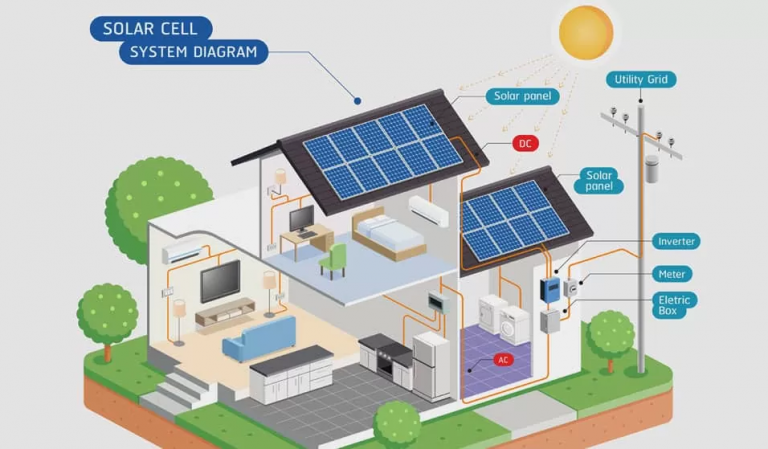The solar industry is projected to reach a whopping 230 billion dollars by 2026. Nowadays, numerous opportunities are available online where solar power is related. Most governments and organizations worldwide are giving tax rebates to incentivize the use of sun energy to put the problem of pollution under control.
This article gives you current information on the energy production of solar panels to allow you to be part of a greater energy revolution.
How does a home solar system work?
Saying “Yes!” to our flexible deals is not the only issue. You should also check how your home can change sunlight into valuable power. When selecting a contractor, it is advisable to look at the solar panels power output to experience the cleanest renewable energy benefits.
Before making your choice, it is essential to consider solar panel power generation which involves a few simple processes. Solar panels directly produce Direct Current (DC) electricity, while the grid and most of the devices in the building use Alternating Current (AC).
DC flows in one direction, hence limiting its ability to change voltage when needed. However, AC changes the direction of voltage easily, making it the more preferred option for use in homes. The sun panel cells collect sunshine and transform the rays into Direct Current (DC) in the correct orientation. The drawback here is that DC merely powers small gadgets like cell phones and spotlights. Therefore, an inverter is required to change the DC produced by the solar panels to AC.
Buy our smarter inverter to convert DC to AC for the robust gadgets at home but also cast a keen eye on the solar panel size and output.
What factors affect the output efficiency?
Before a contractor bombards you with a lot of unnecessary information, you must initially know what factors might impact the output quality of your PV systems. We take a look at the most crucial metrics:
PV cells effectiveness
Even though sunlight is free, many sun-powered systems turn 20% of this clean energy into a usable form. The ones that convert about 40% or 50% normally cost an arm and a leg but occupy minimum roof area.
Roof’s orientation
The output of a solar panel mostly rests on direction and tilt. In the northern hemisphere, efficient PV cells are South-facing and tilt between 25-30 degrees. If you can’t find the optimum angle for your installation, check our technicians for competent services.
How do you calculate solar power output for your house?
The local company was quick to install PV technology in your home, and this is how you couldn’t ask how much power does a solar panel produce?
You can now rest because we help you confirm the solar panel kwh output before buying not as easily as you reset your r22 refrigerators and other appliances.
For starters, here’s an easy bit-by-bit formula to calculate PV systems power output:
Average sunlight hours x panel watts x 75% = per/day watt-hours
You like examples, and so let’s assume you purchase the 325-watt Innovate Solar, and your home receives 6 hours of maximum sunshine on average. Wait!
Why do we need 75%? It covers the shade, efficiency, and orientation factors.
6 hours x 325-watts x 0.75 = 1462. 5 daily watt-hours
Converting 1462. 5 daily watt-hours into the normal metrics on your power bill just divide by 1000.
1462. 5/ 1000 = 1. 4625 kwh
But, if you are a homeowner and in a hurry, this online calculator will help you calculate the solar panels output per day.
How many solar panels do you need to power an average house?
You contemplate how much energy do solar panels produce in an average home? That is a common question in renewable tech discussions. The quantity of power is contingent on the number of photovoltaic systems installed.
Using a simple formula, we can determine the number of panels an average home will need;
Number of panels = Size of system/ Ratio of production/ Panel wattage.
In conformation to standing data, an American home on average will use about 10, 620 KWh annually. The panel wattage is usually somewhere between 250 and 400 Watts. The production ratio is determined by the evaluated power output and the system size. A 10KW system producing 16 KWh each year has a ratio of 1:6. On average, this ratio for an American home is usually between 1.3 and 1.6.
With these values;
Number of panels = 10,620/1.4/320 =23.7W
Therefore, the average American home requires about 20 to 25 solar panels to match its demands. Still, the real number is dependent on location, your electricity usage, PV cells quality, installer, and shade.
Bottomline
We have learned that the average solar panel efficiency is controlled by solar panel sizes and wattage, among other issues that our technicians will take care of.
Innovate Solar is an online solar energy marketplace that connects sellers, distributors, and installers and provides service that helps find reliable solar companies nearby to run the water heaters and other appliances efficiently.
We install high-quality rooftop solar panels to help reduce electricity costs while adding value to your home. Our online marketplace is designed to offer solar panels power output and increase innovation for installers, sellers, and distributors within the solar industry.
Contact us now and our in-house team will gladly assist in making the best installation decisions.

